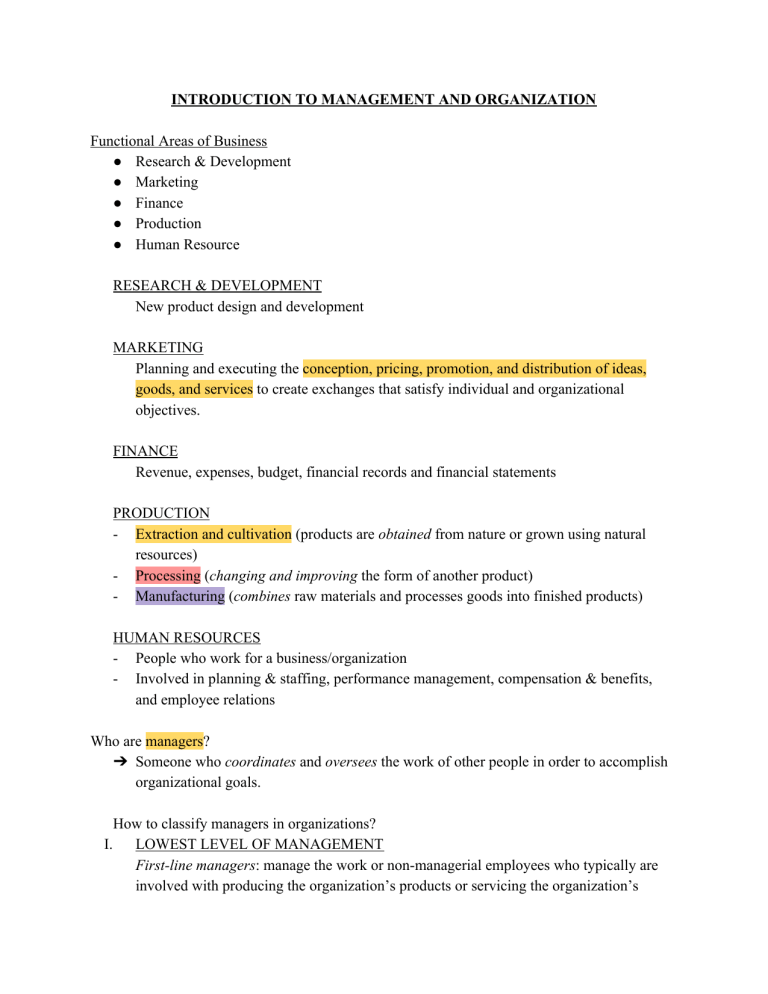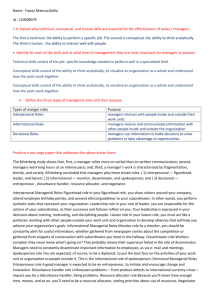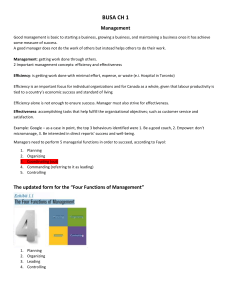
INTRODUCTION TO MANAGEMENT AND ORGANIZATION Functional Areas of Business ● Research & Development ● Marketing ● Finance ● Production ● Human Resource RESEARCH & DEVELOPMENT New product design and development MARKETING Planning and executing the conception, pricing, promotion, and distribution of ideas, goods, and services to create exchanges that satisfy individual and organizational objectives. FINANCE Revenue, expenses, budget, financial records and financial statements PRODUCTION - Extraction and cultivation (products are obtained from nature or grown using natural resources) - Processing (changing and improving the form of another product) - Manufacturing (combines raw materials and processes goods into finished products) HUMAN RESOURCES - People who work for a business/organization - Involved in planning & staffing, performance management, compensation & benefits, and employee relations Who are managers? ➔ Someone who coordinates and oversees the work of other people in order to accomplish organizational goals. How to classify managers in organizations? I. LOWEST LEVEL OF MANAGEMENT First-line managers: manage the work or non-managerial employees who typically are involved with producing the organization’s products or servicing the organization’s customer. They are often called: supervisor, shift manager, district manager, department manager, office manager II. MIDDLE LEVEL OF MANAGEMENT Middle managers: manage work of first-line managers They are often called: regional manager, project leader, store manager, division manager III. UPPER LEVEL OF MANAGEMENT Top managers: are responsible for making organization-wide decisions and establishing the plans and goals that affect the entire organization They are often called: executive vice president, president, managing director, chief operating officer, chief executive officer What is Management? ● Management is the art of getting work done through others. ● Management involves coordinating and overseeing the work activities of others so that their activities are completed efficiently and effectively. EFFICIENCY - getting the most output from the least amount of inputs - “doing things right” - concerned with ways (means) of getting things done - getting work done with a minimum effort, expense, or waste - (use resources - people, money, raw materials - wisely and cost-effectively) EFFECTIVENESS - do those work activities that will help the organization reach its goals - “doing the right things” - concerned with ends (result) of organizational goal achievement - accomplish tasks that help fulfil organizational objectives - (make the right decisions and successfully carry them out to accomplish the organization’s goal) MANAGEMENT FUNCTIONS 1. Planning a. Define goals b. Establish strategies for achieving those goals c. Develop plans to integrate and coordinate activities “Setting goals and plans (how to achieve them” 2. Organizing a. Determine i. What tasks are to be done? ii. Who will do them? iii. How tasks are to be grouped? iv. Who reports whom? v. Where decisions are to be made? “Arrange tasks and other resources to accomplish the organization’s goals.” 3. Leading a. Motivate subordinates (lower positions) b. Help resolve group conflicts c. Influence individuals or teams as they work d. Select the most effective communication channel e. Deal with employee behavior issues “Hire, train, motivate (lead) people” 4. Controlling a. Monitor activities’ performance b. Compare actual performance with the set goals c. Evaluate activities’ performance whether things are going as planned d. Correct any disturbance to get work back on track and achieve the set goals “Ensure all activities are accomplished as planned” 5. Other Functions: a. Decision Making i. Determines the available alternatives and chooses the best solution that suits a given problem. b. Communicating i. Transferring information from one communicator to another. c. Motivating i. Act of giving employees reasons or incentives to work in order to achieve organizational objectives. AREA OF MANAGEMENT ● Functional Manager is responsible for just one organizational activity ● General Manager is responsible for several organizational activities. MANAGERS FOR 3 TYPES OF ORGANIZATIONS 1. For-Profit Organizations: For making money, or profits, by offering products or services. 2. Nonprofit Organizations: For offering services in either public sector or private sector such as hospitals, colleges, social-welfare agencies 3. Mutual-Benefit Organizations: For aiding members such as farm cooperatives, labor union, trade associations, and clubs MANAGEMENT FOR DIFFERENT TYPES OF ORGANIZATIONS Similarities Differences 4 management functions: planning, organizing, leading, and controlling are needed for all types Measurement of success For-profit: how much profit (or loss) it generates Nonprofit & Mutual-benefit: effectiveness of services delivered MANAGEMENT ROLES ● Specific actions or behaviors expected of a manager ● 3 Types of Managerial Roles: ○ Interpersonal ○ Informational ○ Decisional MINZBERG\S MANAGERIAL ROLES ➔ Interpersonal Roles: involves people (subordinates and person outside the organization) and other duties that are ceremonial and symbolic in nature ➔ Informational Roles: involve collecting, receiving, and disseminating information ➔ Decisional Roles: entail making decisions or choices MANAGERIAL ACTIVITIES ASSOCIATED ROLES Interpersonal Roles: arising from formal authority and status and supporting the information and decision activities ● Figurehead ● Liaison ● Leader Informational Roles ● Monitor ● Disseminator ● Spokesman Decisional Roles: making significant decisions ● ● ● ● I. II. III. Improver/Changer (entrepreneur) Disturbance Handler Resource Allocator Negotiator INTERPERSONAL ROLES A. Figurehead: perform ceremonial duties like greeting company visitors, speaking at the opening of a new facility, or representing the company at a community luncheon to support local charities B. Leader: motivate and encourage workers to accomplish organizational objectives C. Liaison: deal with people outside their units to develop alliances that will help in organizational goal achievement INFORMATIONAL ROLES A. Monitor: scan environment for information, actively contact others for information, continually update news/stories related to their business (inside & outside the organization) B. Disseminator: share the information they have collected with their subordinates and others in the company C. Spokesperson: share information with people outside their departments and companies DECISIONAL ROLES A. Entrepreneur: adapt themselves, their subordinates, and their units to change/innovatio B. Disturbance Handler: respond to pressures and problems that demand immediate attention and action C. Resource Allocator: set priorities and decide about use of resources D. Negotiator: continual negotiate schedules, projects, goals, outcomes, resources, and employee raises in order to accomplish the goals MANAGEMENT SKILLS ❏ Technical Skills: job-specific knowledge and techniques needed to proficiently perform work tasks ❏ Human Skills: ability to work well with other people both individually and in a group ❏ Conceptual Skills: ability to sse the organization as a whole, understand the relationships among various subunits, visulize how the organization fits into its external environment SKILLS NEEDED AT DIFFERENT MANAGERIAL LEVELS Top Managers Middle Managers Low-level Managers CONCEPTUAL SKILLS HUMAN SKILLS TECHNICAL SKILLS WHAT IS AN ORGANIZATION? - A deliberate arrangement of people to accomplish some specific purpose WHY STUDY MANAGEMENT? ➔ The universality of management ◆ The reality that management is needed in all types, sizes, level, areas of organizations. ➔ The reality of work ◆ You will either manage or be managed in your future career ➔ Rewards ang challenges of being a manager REWARDS CHALLENGES Create work environment where the organization’s members can work to the best of their ability Does the hard work Have opportunity to think creatively & use imagination May have duties that are more clerical than managerial Help others find meaning & fulfillment in work Have to deal with a variety of personalities Support, coach, and nurture others Often have to deal with limited resources Work with a variety of people Motivate workers in chaotic and uncertain sittuations Receive recognition & status in the organization and community Blend knowledge, skills, ambitions, and experiences of a diverse workgroup Play a role in influencing organizational outcomes Success depends on other’s work performace Receive appropriate compensation in form of salaries, bonuses, and stock options WHAT IS AN ORGANIZATION? - Is a collection of people working together to achieve a common purpose FUNCTIONS OF ORGANIZATIONS ● Common Characteristics of Organizations ○ Coordination of effort - produce better outpurs ○ Common goal or purpose - risk of failure ○ Division of labor - be poor production ○ Hierarchy of authority - chain of command BASIC PRINCIPLES OF MANAGEMENT AND ORGANIZATION ● Management Principles ○ Division of Labor - breaking a job for productivity ○ Authority - give orders and the power to exact obedience ○ Discipline - uniform application of behavior ○ Unity of Command - one supervisor ○ Unity of Direction - efforts of the organization as a whole ● ● ● ● ○ Subordination of the individual interests to the general interest - ROI and salary increase ○ Remuneration - employees should be paid fairly ○ Centralization - centralized power and authority ○ Scalar Chain - subordinates must observe the official chain of command ○ Order - human and non-human resources must be in their proper places ○ Equity - kindliness and justice ○ Stability of Tenure - effective manpower planning ○ Initiative - the ability to assess and initiate things independently ○ Espirit de Corps - teamwork and harmony Objective ○ The objective of the organization must first be determined and laid out clearly before any activity is undertaken Analysis ○ Managers in an organization must be able to break a problem down into its components Simplicity ○ Simplest manner that could make the achievement of objective possible Functionalization ○ Built around the functions of the services



